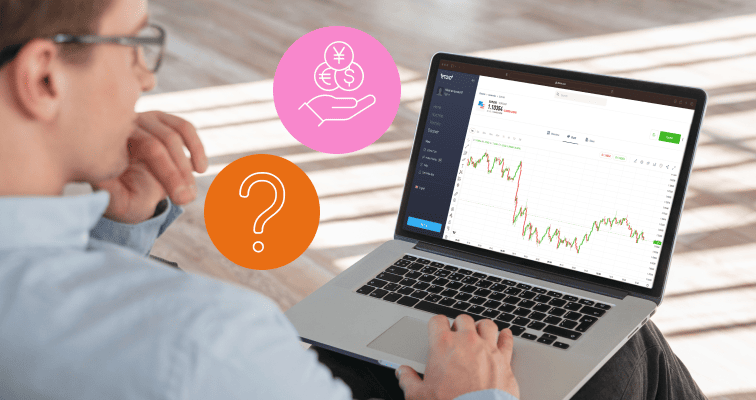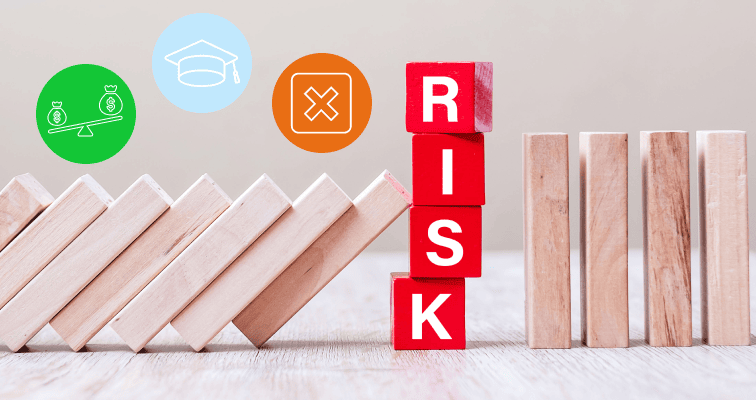Looking to enter the exciting world of forex trading? Find out more about how forex trading works, the risks and rewards, and helpful trading tips.
While you have probably heard plenty about crypto, stocks, indices and ETFs, you might not be as familiar with forex or currency trading. And what might be even more surprising is that the forex market is the largest market in the world, with an average daily trading volume of over $5 trillion!
Currency trading provides multiple opportunities for active traders, but forex trading can be intimidating for beginners. This guide provides an overview to help you start trading forex.

What is currency trading?
So, what exactly is currency trading?
The currency market refers to the overall market in which people are able to buy and sell international currency. Sometimes, it is also referred to as the foreign exchange market, forex or the FX market, and market trading hours/times run 24 hours a day in different parts of the world.
Find out more about currency trading with our educational video.
The forex market provides the opportunity for those with relatively small amounts of capital to still be able to invest. Traders invest in exchange rate pairs to trade one fiat currency against another, in the hope of benefitting from fluctuations in currency exchange rates. You sell one currency to buy another, which makes a pair.
So, for example, you might want to invest in USD/AUD, thinking that the USD will become stronger against the AUD. This isn’t very different to when you used to exchange your native cash at the airport when travelling overseas.
While the term forex is a shortened version of “foreign exchange,” there is not a specific marketplace or platform on which currencies are traded.

How to invest or trade forex
The basic idea behind investing or trading forex is quite straightforward. If you believe the value of a particular currency may rise in relation to another, you can buy that currency and then sell it later for a potential profit.
You may choose to select a currency pair or may look to invest in a currency ETF, providing exposure to the performance of a currency when compared to another or a broader basket of currencies.
Technical analysts are particularly drawn to trading in currencies due to the volatility of currency exchange rates. In the right conditions, this volatility can lead to higher profits, but it is important to remember that exchange rates are influenced by an assortment of factors, ranging from political events to central bank policies.
Some investors also use currencies to hedge their forex exposure. If, for example, an investor’s portfolio was to contain a high proportion of GBP and they invest in a company that is dominated by USD, they may opt to short sell the USD to neutralise the effect the currency has on the portfolio.
Certain currencies are considered “safe-haven” investments. This means that they are viewed as less risky by investors than those from emerging markets. Some common “safe-haven” currencies include the US dollar, the Japanese yen and the Swiss franc. When the market is unsettled, it is not uncommon for investors to turn to these currencies.
Now that you have an understanding of what forex is, it’s time to start trading forex. Here are four steps to follow to start forex trading:
1. Choose a currency pair
Trading in currencies involves buying one fiat currency while selling another simultaneously. This is why they are called “currency pairs.” You can go with common pairs of major currencies or more obscure currency pairs.
2. Review the market
Constant learning and research are key to being a competent trader. Take your time researching your favourite currency pairs and keep an eye on both current and historical charts. Also, read about daily economic announcements and search for other technical and fundamental analysis news on your chosen currencies.
3. The quote
The quote — or “term currency” — has two rates, indicating the two currencies (e.g., USD and EUR). The first rate is the price for which you can sell the currency pair (also known as the “bid” price), while the second rate is that at which you can buy it (also known as the “ask/offer” price). The difference between the two rates is known as the “spread,” which is what a forex broker charges you for carrying out the trade.
4. Choose a position
In forex trading, you have to consider both the up and down movements in the market — because you are both buying a currency and selling another at the same time.
In terms of having a “buy position,” you expect the base currency’s value to rise compared to the quote currency (the second currency). Whereas having a “sell position” means you expect the base currency’s value will fall compared to the quote currency.
Tip: Set financial goals and create a plan before you invest to help mitigate risk.
What are currency pairs?
A currency pair is exactly what it sounds like — a pair of currencies. In forex trading, a currency pair shows which type of currency is being traded for another. Or, in another way of looking at it, it shows how much of one type of currency it costs to purchase one unit of another type of currency, following a similar principle to other forms of pairs trading.
The way in which the currencies are listed in the pair matters. The first currency listed in a currency pair is the base currency. The second is called the quote currency. The currencies are listed by standardised abbreviations used in markets around the world.
For example, let’s say you are looking at a forex market, and you see AUD/USD = 1.10000. The AUD represents Australian dollars, which is the base currency. The USD represents US dollars, which is the quote currency. That means you can exchange 1.10 US Dollars for 1 Australian Dollar.

Risks of forex trading
Every investment opportunity comes with risks that potential traders need to be aware of. Here are a few of the major risks to think about before you get started.
Leverage
If you get in too deep with real leverage, you can quickly lose a large portion of your capital with even a small shift in the market.
Failure
It is no fun to think about failing when it comes to investing, and nobody plans on losing money when they enter a market. But it is important to go into forex trading with your eyes open.
Education
To be a successful forex trader, you need to have a big-picture understanding of global economies and what makes them tick. Getting a handle on so many global factors can be a barrier to success for relative newcomers.
Forex trading can be an excellent opportunity for traders with various levels of experience and capital available for investment. It provides you with access to a truly global market that is the largest in the world. Of course, it also comes with risk, as does any investment opportunity.
Quiz
FAQs
- What’s different about forex trading compared to traditional share trading?
-
There is no central governing body for foreign exchange trading — this is in contrast to stocks, futures and options trading.
- What hours is forex trading open?
-
The forex market runs 24 hours on weekdays and can be used to assess potential price movements in the future.
This information is for educational purposes only and should not be taken as investment advice, personal recommendation, or an offer of, or solicitation to, buy or sell any financial instruments.
This material has been prepared without regard to any particular investment objectives or financial situation and has not been prepared in accordance with the legal and regulatory requirements to promote independent research. Not all of the financial instruments and services referred to are offered by eToro and any references to past performance of a financial instrument, index, or a packaged investment product are not, and should not be taken as, a reliable indicator of future results.
eToro makes no representation and assumes no liability as to the accuracy or completeness of the content of this guide. Make sure you understand the risks involved in trading before committing any capital. Never risk more than you are prepared to lose.


